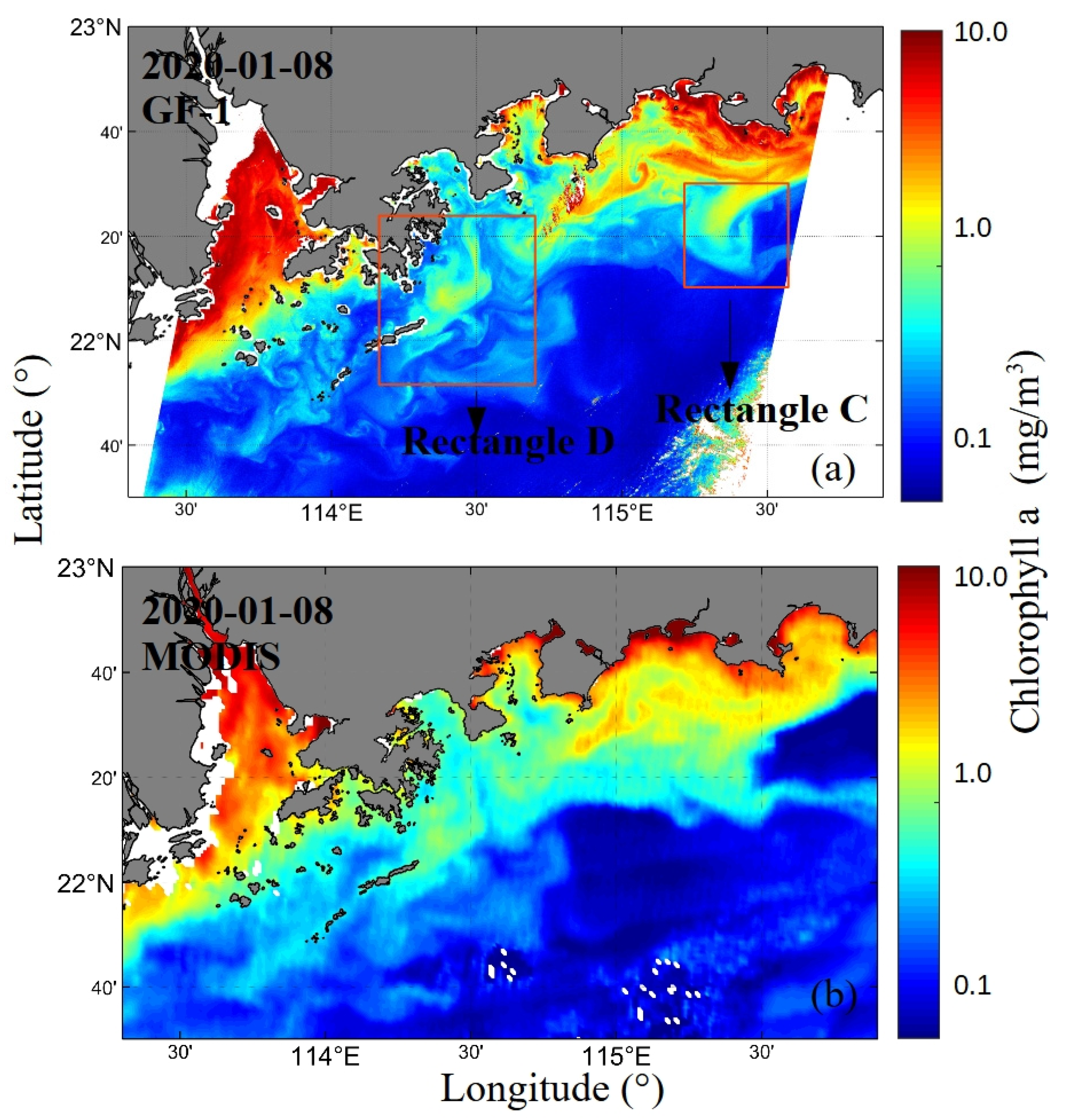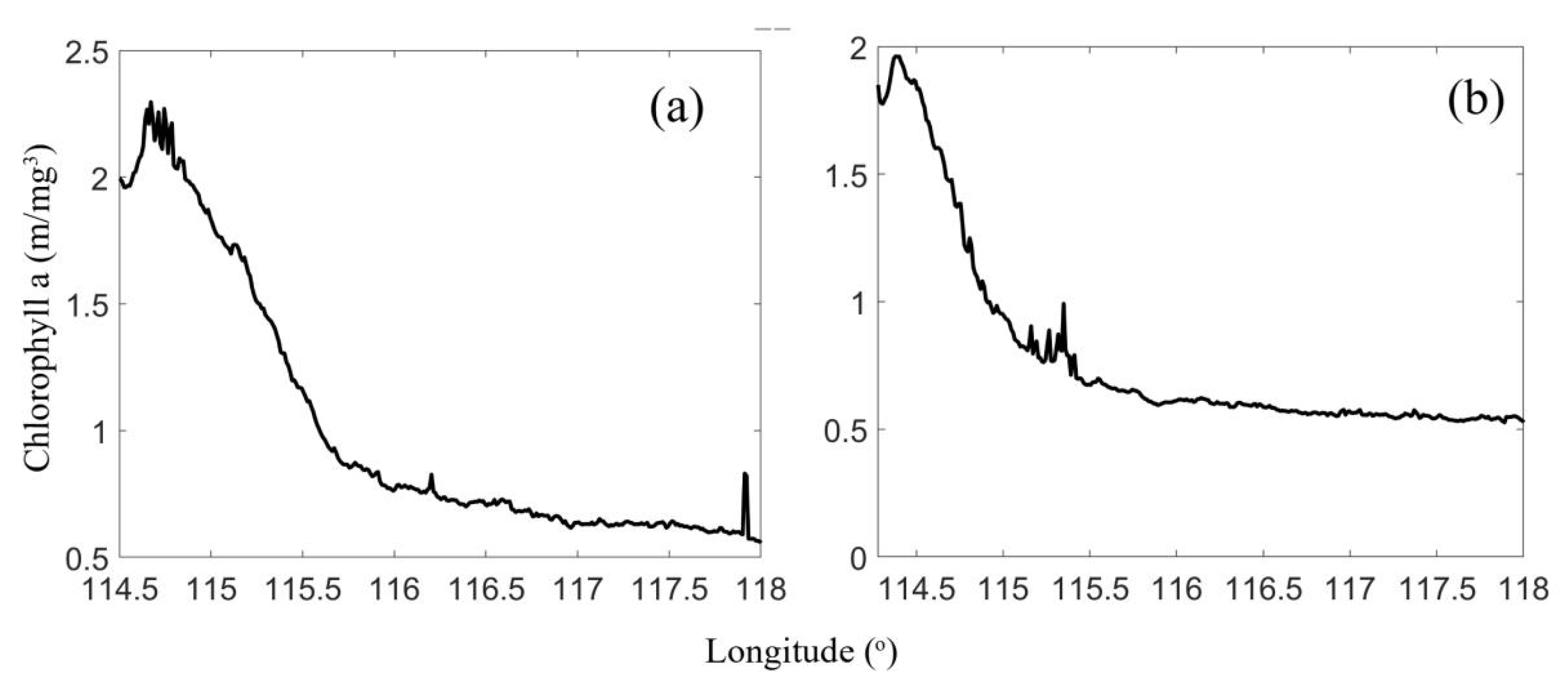Enhanced Chlorophyll-a in the Coastal Waters near the Eastern Guangdong during the Downwelling Favorable Wind Period
Abstract
:1. Introduction
2. Materials and Method
2.1. Satellite Data Acquisition and Processing
2.2. In Situ Data
2.3. Method
2.3.1. Model for Chl a Retrieval
2.3.2. Model for Kd (490) Retrieval
2.3.3. Ekman Pumping
2.3.4. EOF
2.3.5. The Modelling Sensor Spectral Reflectance
2.3.6. The Standard Deviation
3. Results
3.1. Chl a Retrieval Model Assessment
3.2. Chlorophyll a Distribution in the Coastal Waters of EGD
3.3. The Temporal Variation of the Mean Chl a
3.4. EOF Modes of Chl a
3.5. Cross-Shelf Jet Observed in GF-1
4. Conclusions
Author Contributions
Funding
Acknowledgments
Conflicts of Interest
References
- Bakun, A. Coastal Upwelling Indices, West Coast of North America; U.S. Department of Commerce: Seattle, WA, USA, 1973.
- Barsi, J.; Lee, K.; Kvaran, G.; Markham, B.; Pedelty, J. The spectral response of the Landsat-8 Operational Land Imager. Remote Sens. 2014, 6, 10232–10251. [Google Scholar] [CrossRef] [Green Version]
- Brewin, R.J.; Sathyendranath, S.; Müller, D.; Brockmann, C.; Deschamps, P.-Y.; Devred, E.; Doerffer, R.; Fomferra, N.; Franz, B.; Grant, M.; et al. The Ocean Colour Climate Change Initiative: III. A round-robin comparison on in-water bio-optical algorithms. Remote Sens. Environ. 2013, 162, 271–294. [Google Scholar] [CrossRef] [Green Version]
- Cianelli, D.; D’Alelio Uttieri, M.; Sarno, D.; Zingone, A.; Zambianchi, E.; d’Alcalà, M.R. Disentangling physical and biological drivers of phytoplankton dy-namics in a coastal system. Sci. Rep. 2017, 7, 15868. [Google Scholar] [CrossRef] [PubMed] [Green Version]
- Chen, C.-C.; Shiah, F.-K.; Chung, S.-W.; Liu, K.-K. Winter phytoplankton blooms in the shallow mixed layer of the South China Sea enhanced by upwelling. J. Mar. Syst. 2006, 59, 97–110. [Google Scholar] [CrossRef]
- Chen, C.-T.A. Distributions of nutrients in the East China Sea and the South China Sea connection. J. Oceanogr. 2008, 64, 737–751. [Google Scholar] [CrossRef]
- Cummings, J.A.; Smedstad, O.M. Variational Data Assimilation for the Global Ocean. In Data Assimilation for Atmospheric, Oceanic and Hydrologic Applications; Park, S., Xu, L., Eds.; Springer: Berlin, Germany, 2013; Volume 2, pp. 303–343. [Google Scholar] [CrossRef]
- Deng, A.; Ye, C.; Liu, W. Spatial and Seasonal Patterns of Nutrients and Heavy Metals in Twenty-Seven Rivers Draining into the South China Sea. Water 2018, 10, 50. [Google Scholar] [CrossRef] [Green Version]
- Fang, G.H.; Fang, W.D.; Fang, Y. A survey of studies on the South China Sea upper ocean circulation. Acta Oceanogr. Taiwanica 1998, 37, 1–16. [Google Scholar]
- Garver, S.A.; Siegel, D.A. Inherent optical property inversion of ocean color spectra and its biogeochemical interpretation: 1. Time series from the Sargasso Sea. J. Geophys. Res. Earth Surf. 1997, 102, 18607–18625. [Google Scholar] [CrossRef]
- Gan, J.; Li, L.; Wang, D.; Guo, X. Interaction of a river plume with coastal upwelling in the northeastern South China Sea. Cont. Shelf Res. 2009, 29, 728–740. [Google Scholar] [CrossRef]
- Gan, J.; Ho, H.S.; Liang, L. Dynamics of Intensified Downwelling Circulation over a Widened Shelf in the Northeastern South China Sea. J. Phys. Oceanogr. 2013, 43, 80–94. [Google Scholar] [CrossRef]
- Gu, Y.; Pan, J.; Lin, H. Remote sensing observation and numerical modeling of an upwelling jet in Guangdong coastal water. J. Geophys. Res. Earth Surf. 2012, 117, C08019. [Google Scholar] [CrossRef] [Green Version]
- Guan, B.X.; Chen, S.J. The Current Systems in the Near-Sea Area of China Seas; Initial Report 5; Institute of Oceanology, Chinese Academy of Science: Beijing, China, 1964; 85p. (In Chinese) [Google Scholar]
- Gordon, H.R.; Brown, O.B.; Evans, R.H.; Brown, J.W.; Smith, R.C.; Baker, K.S.; Clark, D.K. A Semianalytic Radiance Algorithm of Ocean Color. J. Geophys. Res. 1988, 93, 10909–10924. [Google Scholar] [CrossRef]
- Han, A.Q.; Dai, M.H.; Gan, J.P.; Kao, S.-J.; Zhao, X.Z.; Jan, S.; Li, Q.; Lin, H.; Chen, C.-T.A.; Wang, L.; et al. Inter-shelf nutrient transport from the East China Sea as a major nutrient source supporting winter primary production on the northeast South China Sea shelf. Biogeosciences 2013, 10, 8159–8170. [Google Scholar] [CrossRef] [Green Version]
- He, Q.; Zhan, H.; Xu, J.; Cai, S.; Zhan, W.; Zhou, L.; Zha, G. Eddy-Induced Chlorophyll Anomalies in the Western South China Sea. J. Geophys. Res. Oceans 2019, 124, 9487–9506. [Google Scholar] [CrossRef]
- Lewis, K.M.; Arrigo, K.R. Ocean color algorithms for estimating chlo-rophyll a, cdom absorption, and particle backscattering in the arctic ocean. J. Geophys. Res. Ocean. 2020, 125, e2019JC015706. [Google Scholar] [CrossRef]
- Liu, C.; Xia, H.; Wang, D. 2010, The Observation and Analysis of Eastern Guangdong Coastal Down welling in the winter of 2006 (In Chinese). Acta Oceanol. Sin. 2010, 32, 1–9. [Google Scholar]
- Liu, K.-K.; Chao, S.-Y.; Shaw, P.-T.; Gong, G.-C.; Chen, C.-C.; Tang, T. Monsoon-forced chlorophyll distribution and primary production in the South China Sea: Observations and a numerical study. Deep Sea Res. Part I Oceanogr. Res. Pap. 2002, 49, 1387–1412. [Google Scholar] [CrossRef]
- Liu, S.M.; Hong, G.-H.; Zhang, J.; Ye, X.W.; Jiang, X.L. Nutrient budgets for large Chinese estuaries. Biogeosciences 2009, 6, 2245–2263. [Google Scholar] [CrossRef] [Green Version]
- Maisyarah, S.; Wirasatriya, A.; Marwoto, J.; Subardjo, P.; Prasetyawan, I.B. The Effect of the ENSO on the Variability of SST and Chlorophyll-a in the South China Sea. IOP Conf. Ser. Earth Environ. Sci. 2019, 246, 012027. [Google Scholar] [CrossRef]
- Maritorena, S.; Siegel, D.A.; Peterson, A.R. Optimization of a semianalytical ocean color model for global-scale applications. Appl. Opt. 2002, 41, 2705–2714. [Google Scholar] [CrossRef]
- Maritorena, S.; Siegel, D.A. Consistent merging of satellite ocean color data sets using a bio-optical model. Remote Sens. Environ. 2005, 94, 429–440. [Google Scholar] [CrossRef]
- Morel, A.; Gentili, B. Diffuse reflectance of oceanic waters: Its depend-ence on Sun angle as influenced by the molecular scattering contribution. Appl. Opt. 1991, 30, 4427–4438. [Google Scholar] [CrossRef] [PubMed]
- Morel, A.; Gentili, B. Diffuse reflectance of oceanic waters. III. Implica-tion of bidirectionality for the remote sensing problem. Appl. Opt. 1996, 35, 4850–4862. [Google Scholar] [CrossRef] [PubMed]
- Mueller, J.L.; Austin, R.W. Ocean Optics Protocols for SeaWiFS Validation, Revision 1. Oceanogr. Lit. Rev. 1995, 9, 805. [Google Scholar]
- Mueller, J.L. Radiometric Measurements and Data Analysis Protocols; Goddard Space Flight Center: Greenbelt, MD, USA, 2003.
- Kuo, N.-J.; Ho, C.-R.; Lo, Y.-T.; Huang, S.-J.; Chang, L. Analysis of chlorophyll-a concentration around the South China Sea from ocean color images. In Proceedings of the OCEANS 2009-EUROPE, Bremen, Germany, 11–14 May 2009; pp. 1–4. [Google Scholar] [CrossRef]
- Oczkowski, A.; Nixon, S. Increasing nutrient concentrations and the rise and fall of a coastal fishery; a review of data from the Nile Delta, Egypt. Estuar. Coast. Shelf Sci. 2008, 77, 309–319. [Google Scholar] [CrossRef]
- Polovina, J.J.; Howell, E.A. Ecosystem indicators derived from satellite re-motely sensed oceanographic data for the North Pacific. Ices J. Mar. Ence 2005, 3, 319–327. [Google Scholar] [CrossRef]
- Rao, Y.R.; Schwab, D.J. Transport and mixing between the coastal and offshore waters in the Great Lakes: A review. Journal of Great Lakes Res. 2007, 33, 202–218. [Google Scholar] [CrossRef] [Green Version]
- Ruddick, K.G.; Ovidio, F.; Rijkeboer, M. Atmospheric correction of SeaWiFS imagery for turbid coastal and inland waters. Appl. Opt. 2000, 39, 897–912. [Google Scholar] [CrossRef] [Green Version]
- Scheinin, M.; Asmala, E. Ubiquitous patchiness in chlorophyll a concen-tration in coastal archipelago of baltic sea. Front. Mar. Sci. 2020, 7, 563. [Google Scholar] [CrossRef]
- Smith, R.L. Upwelling. Oceanogr. Mar. Biol. Annu. Rev. 1968, 6, 11–46. [Google Scholar]
- Smith, V.; Tilman, G.; Nekola, J. Eutrophication: Impacts of excess nutrient inputs on freshwater, marine, and terrestrial ecosystems. Environ. Pollut. 1999, 100, 179–196. [Google Scholar] [CrossRef]
- Shen, C.; Yan, Y.; Zhao, H.; Pan, J.; Devlin, A.T. Influence of monsoonal winds on chlorophyll-α distribution in the Beibu Gulf. PLoS ONE 2018, 13, e0191051. [Google Scholar] [CrossRef] [PubMed] [Green Version]
- Shi, R.; Guo, X.Y.; Wang, D.X.; Zeng, L.; Chen, J. Seasonal variability in coastal fronts and its influence on sea surface wind in the northern South China Sea. Deep-Sea Res. Part II Top. Stud. Oceanogr. 2015, 119, 30–33. [Google Scholar] [CrossRef]
- Tang, D.L.; Kawamura, H.; Dien, T.V.; Lee, M.A. Offshore phytoplankton biomass in-crease and its oceanographic causes in the South China Sea. Mar. Ecol. Prog. Ser. 2004, 268, 31–41. [Google Scholar] [CrossRef]
- Wang, M.; Son, S.; Harding, L.W., Jr. Retrieval of diffuse attenuation coefficient in the Chesapeake Bay and turbid ocean regions for satellite ocean color applications. J. Geophys. Res. Oceans 2009, 114, 15287–15297. [Google Scholar] [CrossRef]
- Welschmeyer, N.A. Fluorometric analysis of chlorophyll a in the presence of chlorophyll b and pheopigments. Limnol. Oceanogr. 1994, 39, 1985–1992. [Google Scholar] [CrossRef]
- Van Der, M.F. Physical principles of optical remote sensing. In Spatial Statistics for Remote Sensing; Stein, A., Van Der Meer, F., Gorte, B., Eds.; Kluwer Academic Publishers: Dordrecht, The Netherlands, 1999; Chapter 3. [Google Scholar]
- Yang, C.; Ye, H. The features of the coastal fronts in the Eastern Guangdong coastal waters during the downwelling-favorable wind period. Sci. Rep. 2021, 11, 10238. [Google Scholar] [CrossRef]
- Qi, Y.; Chen, J.; Wang, Z.; Xu, N.; Wang, Y.; Shen, P.; Lu, S.; Hodgkiss, I.J. Some observations on harmful algal bloom (HAB) events along the coast of Guangdong, southern China in 1998. Hydrobiologia 2004, 512, 209–214. [Google Scholar] [CrossRef]


















| Region | Chl a (mg/m3) | Mean | sd | Max | Median |
|---|---|---|---|---|---|
| Region I | spring | 3.55 | 1.27 | 8.10 | 2.33 |
| Region I | summer | 4.68 | 1.67 | 8.64 | 3.85 |
| Region I | autumn | 3.94 | 1.03 | 5.74 | 3.45 |
| Region I | winter | 3.19 | 0.62 | 4.41 | 2.57 |
| Region II | spring | 1.11 | 0.29 | 2.06 | 0.99 |
| Region II | summer | 1.38 | 0.36 | 2.67 | 1.39 |
| Region II | autumn | 1.43 | 0.27 | 2.03 | 1.44 |
| Region II | winter | 1.52 | 0.34 | 2.76 | 1.53 |
| Region III | spring | 0.74 | 0.20 | 1.03 | 0.73 |
| Region III | summer | 1.14 | 0.30 | 2.17 | 1.12 |
| Region III | autumn | 1.02 | 0.23 | 1.37 | 0.99 |
| Region III | winter | 1.13 | 0.19 | 1.44 | 1.10 |
| Region IV | spring | 0.19 | 0.12 | 0.52 | 0.25 |
| Region IV | summer | 0.34 | 0.10 | 0.58 | 0.30 |
| Region IV | autumn | 0.24 | 0.09 | 0.53 | 0.28 |
| Region IV | winter | 0.42 | 0.09 | 0.84 | 0.50 |
Publisher’s Note: MDPI stays neutral with regard to jurisdictional claims in published maps and institutional affiliations. |
© 2022 by the authors. Licensee MDPI, Basel, Switzerland. This article is an open access article distributed under the terms and conditions of the Creative Commons Attribution (CC BY) license (https://creativecommons.org/licenses/by/4.0/).
Share and Cite
Yang, C.; Ye, H. Enhanced Chlorophyll-a in the Coastal Waters near the Eastern Guangdong during the Downwelling Favorable Wind Period. Remote Sens. 2022, 14, 1138. https://doi.org/10.3390/rs14051138
Yang C, Ye H. Enhanced Chlorophyll-a in the Coastal Waters near the Eastern Guangdong during the Downwelling Favorable Wind Period. Remote Sensing. 2022; 14(5):1138. https://doi.org/10.3390/rs14051138
Chicago/Turabian StyleYang, Chaoyu, and Haibin Ye. 2022. "Enhanced Chlorophyll-a in the Coastal Waters near the Eastern Guangdong during the Downwelling Favorable Wind Period" Remote Sensing 14, no. 5: 1138. https://doi.org/10.3390/rs14051138
APA StyleYang, C., & Ye, H. (2022). Enhanced Chlorophyll-a in the Coastal Waters near the Eastern Guangdong during the Downwelling Favorable Wind Period. Remote Sensing, 14(5), 1138. https://doi.org/10.3390/rs14051138






